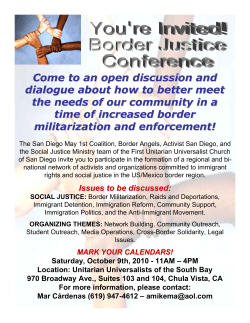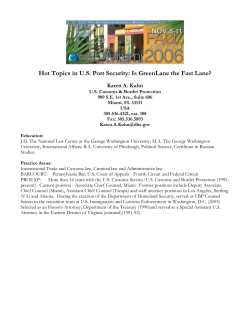
Frequently Asked Questions: The Exodus of Children and
Frequently Asked Questions: The Exodus of Children and Families from Central America Updated 4/28/2015 Who are these “unaccompanied immigrant children”? How do they end up in the United States alone? Unaccompanied immigrant children are minors under the age of 18 who cross the U.S. borders alone, without their parents or caregivers. They come to the United States from all corners of the world, but the most recent children have primarily been from Central America—Mexico, Guatemala, Honduras, and El Salvador. They travel by foot over the border, or as stowaways on freight trains. Sometimes they are victims of human trafficking, sometimes they must pay to get to safety, and sometimes they just travel alone. The number of children making this perilous journey has grown significantly in recent years. Statistics from the U.S. Customs and Border Patrol state that since 2009 over 181,000 unaccompanied children have crossed into the United States. In the fiscal year 2014, over 68,500 children came into the United States, a 77% increase compared to over 38,000 children who arrived alone in 2013. Are entire families also crossing the border? Yes, in addition to the recent increase in unaccompanied immigrant child arrivals, families are also crossing the southernmost border at unprecedented rates. They come to the United States from all corners of the world, however the most recent arrivals are Central American, predominately migrating from Mexico, Guatemala, Honduras and El Salvador. Statistics from the U.S. Customs and Border Patrol state that In the fiscal year 2014 over 68,400 family units came into the United States which was a 361% increase compared to a little over 14,000 family units who arrived in 2013. Why are they fleeing their home countries? Often, the children are leaving their home countries due to extreme poverty, human trafficking, drug cartels, political upheaval, child labor, or abusive homes. In other cases, the children come to the United States to reunite with family members who have preceded them here. Some children are trafficked into the United States, transported by hired smugglers; others make the journey on their own. It is believed that gang-related violence and organized crime in Central America is largely fueling mass exodus to the United States. Due to a powerful drug cartel presence, the homicide rate in Honduras is the highest in the world, at 90.4 per 100,000 according to the Global Study on Homicide 2013. El Salvador and Guatemala were also cited as having some of the highest homicide rates. Central American families fear for their lives and the safety of their children, as many are targets of gang recruitment and/or violence. The families flee to the United States seeking safety and freedom from fear. These safety fears were confirmed in findings from a United Nations High Committee for Refugees (UNHCR) report Children on the Run. How old are the children? They are usually in their early teens, but can be as young as three. They are both boys and girls. What happens to children once they get here? When these children come to the attention of the U.S. government at the border, they are first held at U.S. Customs and Border Protection stations. After the initial steps of checking the children’s health, making sure they are safe, and understanding who they are and the situation they have fled, a determination is made regarding the child’s plan for immediate care. Some of these kids are reunited with family members or other adults who live here in the United States while they wait for an immigration court hearing, some may be returned to the country they came from, and some may be placed into specialized United States foster care programs while their needs for protection are determined by an immigration court. What happens to families when they arrive into the United States? Families are apprehended by U.S. Customs and Border Protection (CBP) and transferred to a family detention center. Thousands of migrants anxiously wait at CBP stations, exhausted, afraid and in need of immediate medical attention. In response, the U.S. government opened facilities to house families in Dilley Texas and Karnes City Texas, which combined, can house over 2,900 women and children. Pregnant mothers, infants and children of all ages through teenagers are being held in these detention centers for months while they await their immigration court hearing. After the hearing, some families will be able to stay in the U.S. while others will be returned to their country of origin. Are these kids and their family members being given permission to the stay in the United States permanently? There is no immediate legal status being offered to these children or their family members. All the children who cross into the United States are still required to abide by U.S. law and must present themselves for immigration court proceedings to determine if they are eligible to remain in the United States. Unfortunately, many families and unaccompanied children have to appear in court without a lawyer due to a shortage of pro-bono lawyers. Some children and mothers may be eligible for asylum or refugee status in the U.S. if they can prove they were a victim of crime in the United States or if they can prove they have been persecuted or abused in their home country. What can I do to help? Everyone can contribute to serving the migrant and refugee community; specifically, we encourage you to join LIRS in these initiatives: Advocate for the end of family detention and lobby for alternatives to family detention. Sign up to receive advocacy updates. Learn more at: LIRS.org/sfw Visit a detention center to provide hope and encouragement to those awaiting their immigration trial. Learn more about this program at: LIRS.org/visitation Become a foster parent: Give the Gift of Family by fostering a refugee or unaccompanied minor child and help promote the program in your community and at your church or in your community. Learn more at: LIRS.org/fostercare Support the work of Lutheran Immigration and Refugee Service. Learn more at: LIRS.org/donate Join Refugee Sunday: Learn about other ways to get involved such as promoting Refugee Sunday and starting other advocacy bible studies at your church. Learn more at: LIRS.org/refugeesunday What is LIRS doing to help? LIRS continues to play a national advocacy role as well as a service role for these women and children throughout this humanitarian crisis. Through support from our donors and funding partners, LIRS provides a variety of initiatives to serve the partner network and to the migrant community. In collaboration with a network of partners, LIRS helps to provide services to unaccompanied migrant children including providing short-term transitional and long-term foster care. The Give the Gift of Family campaign was established in response to a direct need for more foster families to come forward to serve these children. Currently, LIRS is working to implement and provide new programs and resources to support the families and the community serving them. The advocacy team located in the Washington D.C. office remains in front of Congress and the President for the humane treatment and basic human rights for the migrant community. Multiple LIRS staff have visited detention centers around the United States to continue to advocate for an end to detainment of families and children. As one of the many resources LIRS has produced, First Steps is a manual to help refugees, asylum seekers, and migrants navigate the complex system of laws, agencies, and public and private systems they must master by providing important information on legal rights, responsibilities, and eligibility for services and benefits such as healthcare and education, according to immigration status. LIRS programs staff and partners are working with the recently initiated Federal government program for the Central American Minors (CAM) Affidavit of Relationship (AOR) program. Programs supporting sponsors of unaccompanied children and providing mental health services to unaccompanied children at risk from gangs in the U.S. were supported through LIRS crisis response work. To gather together community leaders, LIRS hosted a convening with nonprofit and church leaders of the Lutheran community to talk about push and pull factors in the border crisis and ways to collaborate and share information and resources to better serve the families and children affected. LIRS is also collaborating with U.S. Immigration and Customs Enforcement (ICE) and a strong network of church, social, and legal service partners as well as advocacy allies to push for the release of families into community-based alternatives to detention programs. LIRS is piloting an example of these communitybased alternatives to detention programs to welcome individuals as they enter the United States and/or are released from the custody of ICE and await a final decision on their immigration status. The programs provide culturally appropriate case management, ongoing legal assistance, and housing to individuals who demonstrate a need for such services and are eligible to be released from detention. For more information, contact: LIRS at 1-877-291-1061 or outreach@lirs.org References United States Customs and Border Control statistics: http://www.cbp.gov/newsroom/stats/southwestborder-unaccompanied-children UNHCR Children on the Run report: http://www.unhcrwashington.org/sites/default/files/UAC_UNHCR_Children%20on%20the%20Run_Full%20Report .pdf
© Copyright 2025









